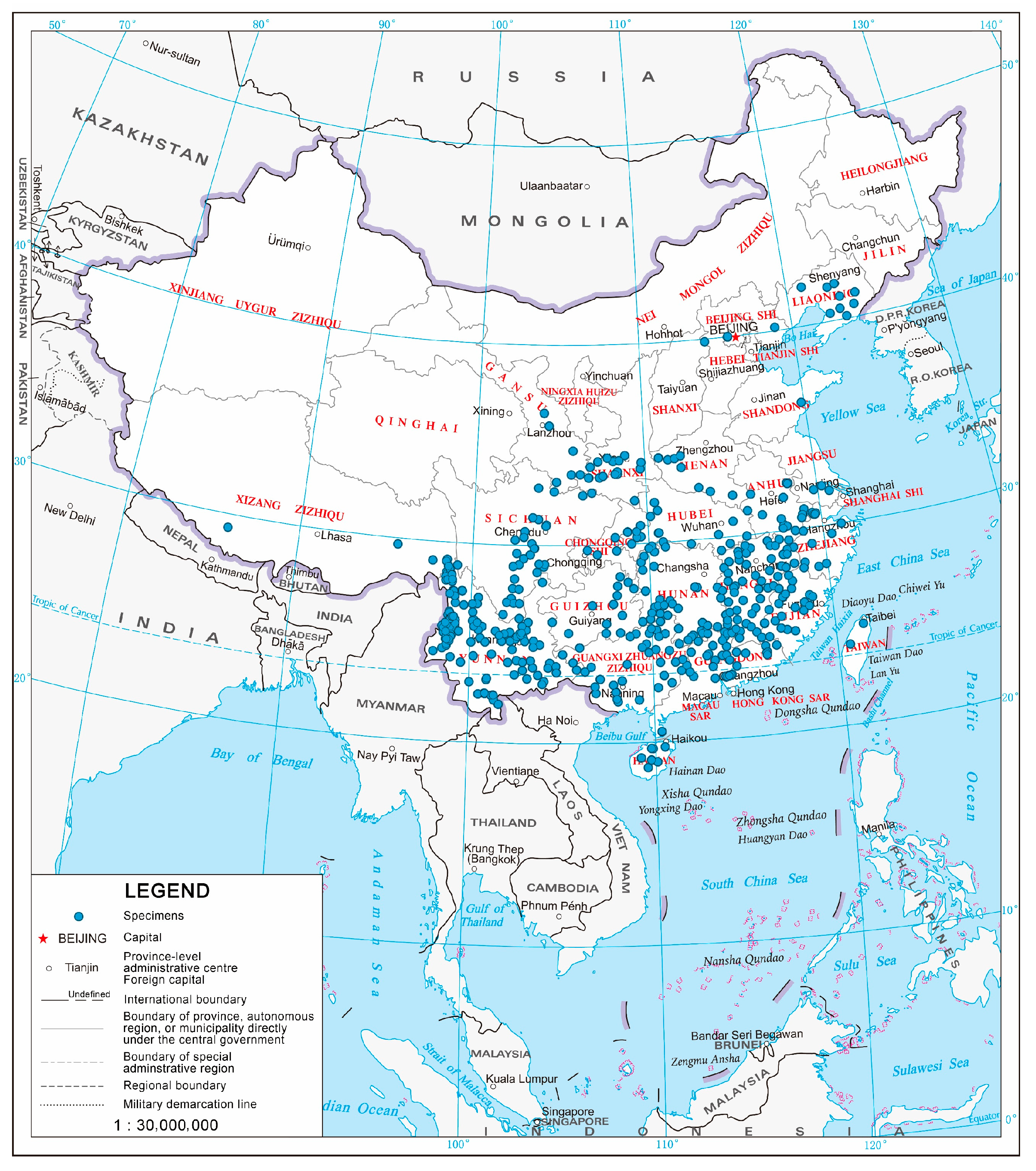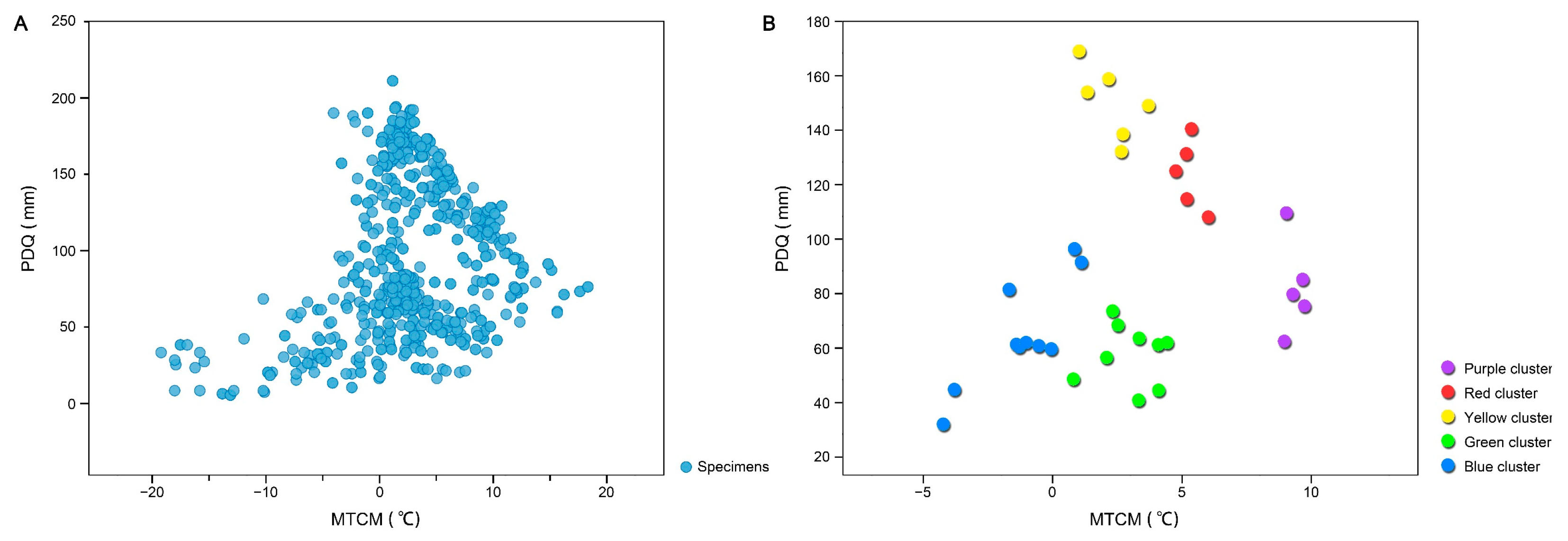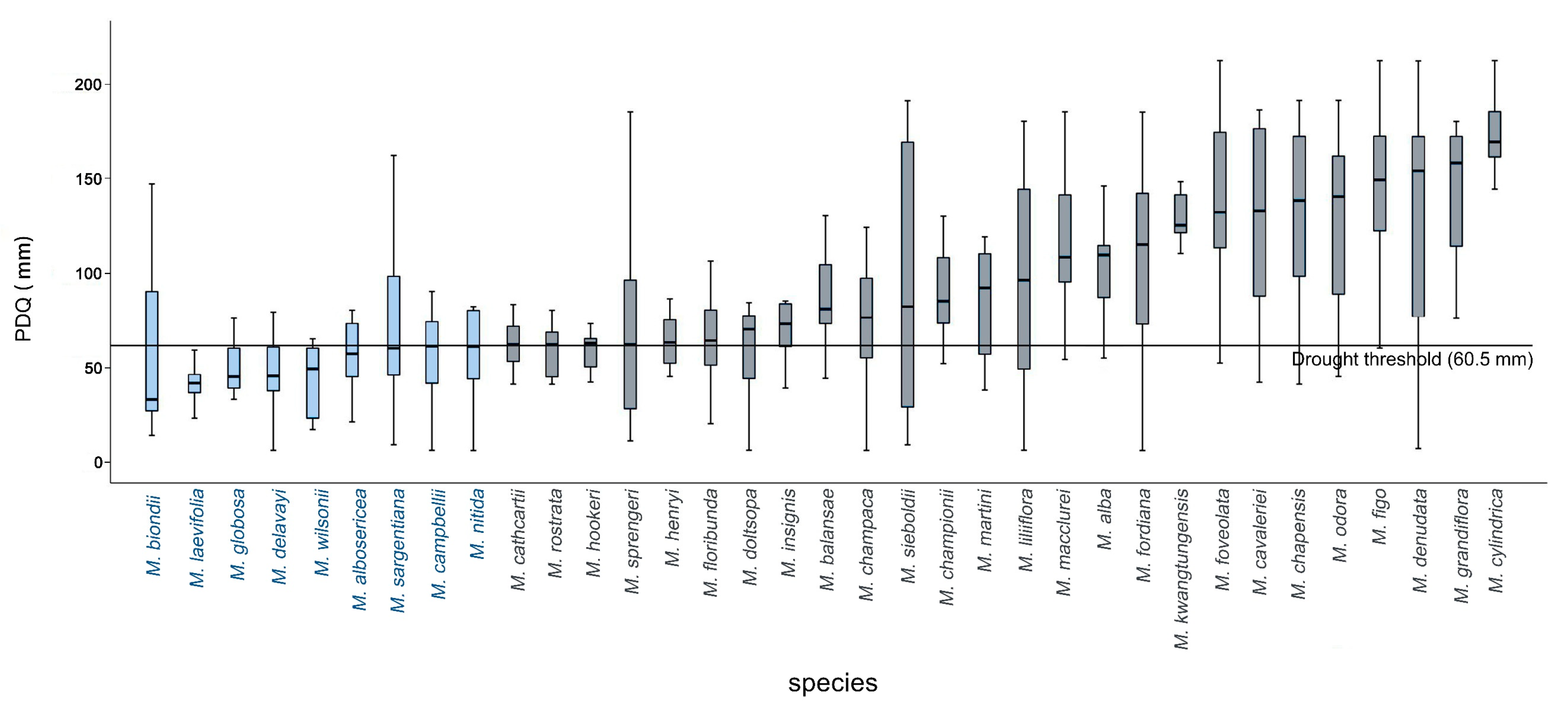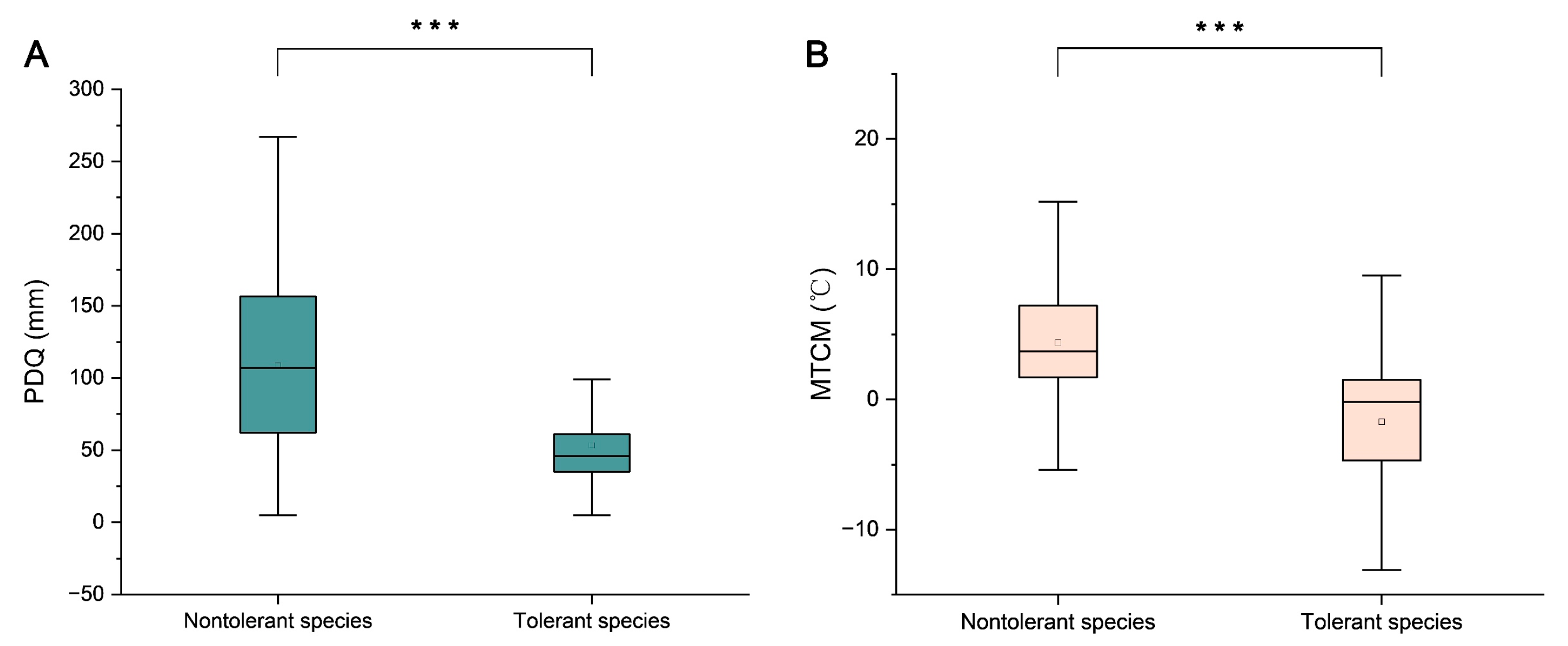Predictive Framework Based on GBIF and WorldClim Data for Identifying Drought- and Cold-Tolerant Magnolia Species in China
Abstract
1. Introduction
2. Materials and Methods
2.1. Species Distribution Data
2.2. Climatic Data
2.3. Data Analysis
3. Results and Analysis
3.1. Distribution Status of Magnolia in China
3.2. Significant Interspecific Variations in Magnolia Distribution Induced by Climate Change
3.3. Magnolia Species with Potential Drought Resistance
3.4. Magnolia Species with Potential Cold Resistance
4. Discussion
5. Conclusions
Supplementary Materials
Author Contributions
Funding
Data Availability Statement
Conflicts of Interest
References
- Lipiec, J.; Doussan, C.; Nosalewicz, A.; Kondracka, K. Effect of drought and heat stresses on plant growth and yield: A review. Int. Agrophys. 2013, 27, 463–477. [Google Scholar] [CrossRef]
- Mondal, R.; Kumar, A.; Gnanesh, B.N. Crop germplasm: Current challenges, physiological-molecular perspective, and advance strategies towards development of climate-resilient crops. Heliyon 2023, 9, e12973. [Google Scholar] [CrossRef] [PubMed]
- Dyderski, M.K.; Paz, S.; Frelich, L.E.; Jagodzinski, A.M. How much does climate change threaten European forest tree species distributions? Glob. Change Biol. 2018, 24, 1150–1163. [Google Scholar] [CrossRef] [PubMed]
- Abri, T.; Borovics, A.; Csajbók, J.; Kovács, E.; Koltay, A.; Keseru, Z.; Rédei, K. Differences in the Growth and the Ecophysiology of Newly Bred, Drought-Tolerant Black Locust Clones. Forests 2023, 14, 1802. [Google Scholar] [CrossRef]
- Ji, L.; Li, P.; Su, Z.; Li, M.; Guo, S. Cold-tolerant introgression line construction and low-temperature stress response analysis for bell pepper. Plant Signal. Behav. 2020, 15, 1773097. [Google Scholar] [CrossRef]
- Tian, Q.; Zhang, H.; Bian, L.; Zhou, L.; Ge, Y. Three-Dimensional Quantification and Visualization of Leaf Chlorophyll Content in Poplar Saplings under Drought Using SFM-MVS. Forests 2024, 15, 20. [Google Scholar] [CrossRef]
- Nunes, C.; Moreira, R.; Pais, I.; Semedo, J.; Simoes, F.; Veloso, M.M.; Scotti-Campos, P. Cowpea Physiological Responses to Terminal Drought-Comparison between Four Landraces and a Commercial Variety. Plants 2022, 11, 593. [Google Scholar] [CrossRef]
- Watkins, J.H.R.; Cameron, R.W.F.; Sjöman, H.; Hitchmough, J.D. Using big data to improve ecotype matching for Magnolias in urban forestry. Urban For. Urban Green. 2020, 48, 126580. [Google Scholar] [CrossRef]
- James, S.A.; Soltis, P.S.; Belbin, L.; Chapman, A.D.; Nelson, G.; Paul, D.L.; Collins, M. Herbarium data: Global biodiversity and societal botanical needs for novel research. Appl. Plant Sci. 2018, 6, e1024. [Google Scholar] [CrossRef]
- Gong, S.P.; Gao, Y.C.; Duan, H.R.; Ge, Y.; Wei, Y.F. Incorporating physiological data into species distribution models to predict the potential distribution range of the red-eared slider in China. Ecol. Indic. 2023, 154, 110749. [Google Scholar] [CrossRef]
- Lu, W.X.; Wang, Z.Z.; Hu, X.Y.; Rao, G.Y. Incorporating eco-evolutionary information into species distribution models provides comprehensive predictions of species range shifts under climate change. Sci. Total Environ. 2024, 912, 169501. [Google Scholar] [CrossRef] [PubMed]
- Woodward, F.I.; Williams, B.G. Climate and plant distribution at global and local scales. Vegetatio 1987, 69, 189–197. [Google Scholar] [CrossRef]
- Bonetti, M.F.; Wiens, J.J. Evolution of climatic niche specialization: A phylogenetic analysis in amphibians. Proc. R. Soc. B Biol. Sci. 2014, 281, 20133229. [Google Scholar] [CrossRef]
- Gong, X.; Chen, Y.; Wang, T.; Jiang, X.; Hu, X.; Feng, J. Double-edged effects of climate change on plant invasions: Ecological niche modeling global distributions of two invasive alien plants. Sci. Total Environ. 2020, 740, 139933. [Google Scholar] [CrossRef]
- Hosseini, N.; Ghorbanpour, M.; Mostafavi, H. The influence of climate change on the future distribution of two Thymus species in Iran: MaxEnt model-based prediction. BMC Plant Biol. 2024, 24, 269. [Google Scholar] [CrossRef]
- Napier, J.D.; de Lafontaine, G.; Heath, K.D.; Hu, F.S. Rethinking long-term vegetation dynamics: Multiple glacial refugia and local expansion of a species complex. Ecography 2019, 42, 1056–1067. [Google Scholar] [CrossRef]
- Xu, J.; Chai, N.; Zhang, T.; Zhu, T.; Cheng, Y.; Sui, S.; Li, M.; Liu, D. Prediction of temperature tolerance in Lilium based on distribution and climate data. iScience 2021, 24, 102794. [Google Scholar] [CrossRef] [PubMed]
- Garcia-Rosello, E.; Guisande, C.; Manjarres-Hernandez, A.; Gonzalez-Dacosta, J.; Heine, J.; Pelayo-Villamil, P.; Gonzalez-Vilas, L.; Vari, R.P.; Vaamonde, A.; Granado-Lorencio, C.; et al. Can we derive macroecological patterns from primary Global Biodiversity Information Facility data? Glob. Ecol. Biogeogr. 2015, 24, 335–347. [Google Scholar] [CrossRef]
- Fick, S.E.; Hijmans, R.J. WorldClim 2: New 1-km spatial resolution climate surfaces for global land areas. Int. J. Climatol. 2017, 37, 4302–4315. [Google Scholar] [CrossRef]
- Esperon-Rodriguez, M.; Tjoelker, M.G.; Lenoir, J.; Baumgartner, J.B.; Beaumont, L.J.; Nipperess, D.A.; Power, S.A.; Richard, B.; Rymer, P.D.; Gallagher, R.V. Climate change increases global risk to urban forests. Nat. Clim. Change 2022, 12, 950–955. [Google Scholar] [CrossRef]
- Esperon-Rodriguez, M.; Ordoñez, C.; van Doorn, N.S.; Hirons, A.; Messier, C. Using climate analogues and vulnerability metrics to inform urban tree species selection in a changing climate: The case for Canadian cities. Landsc. Urban Plan. 2022, 228, 104578. [Google Scholar] [CrossRef]
- Esperon-Rodriguez, M.; Quintans, D.; Rymer, P.D. Urban tree inventories as a tool to assess tree growth and failure: The case for Australian cities. Landsc. Urban Plan. 2023, 233, 104705. [Google Scholar] [CrossRef]
- Shi, X.; Yin, Q.; Sang, Z.; Zhu, Z.; Jia, Z.; Ma, L. Habitat Distribution Pattern of Rare and Endangered Plant Magnolia wufengensis in China under Climate Change. Forests 2023, 14, 1767. [Google Scholar] [CrossRef]
- Zhang, W.; Zhang, D. 10:00 AM Impact of Climate Changes on Threatened Magnolias in China. Hortscience 2023, 58, S91–S92. [Google Scholar]
- Takahashi, K.; Okuhara, I. Comparison of climatic effects on radial growth of evergreen broad-leaved trees at their northern distribution limit and co-dominating deciduous broad-leaved trees and evergreen conifers. Ecol. Res. 2012, 27, 125–132. [Google Scholar] [CrossRef]
- Vastag, E.; Orlovic, S.; Konopkova, A.; Kurjak, D.; Cocozza, C.; Psidova, E.; Lapin, K.; Kesic, L.; Stojnic, S. Magnolia grandiflora L. shows better responses to drought than Magnolia x soulangeana in urban environment. Iforest-Biogeosci. For. 2020, 13, 575–583. [Google Scholar] [CrossRef]
- Huang, L.; Li, S.; Huang, W.; Jin, J.; Oskolski, A.A. Late Pleistocene glacial expansion of a low-latitude species Magnolia insignis: Megafossil evidence and species distribution modeling. Ecol. Indic. 2024, 158, 111519. [Google Scholar] [CrossRef]
- Zhou, L.; Hou, F.; Wang, L.; Zhang, L.; Wang, Y.; Yin, Y.; Pei, J.; Peng, C.; Qin, X.; Gao, J. The genome of Magnolia hypoleuca provides a new insight into cold tolerance and the evolutionary position of magnoliids. Front. Plant Sci. 2023, 14, 1108701. [Google Scholar] [CrossRef]
- Zhang, X.; He, X.; Gao, J.; Wang, L. Latitudinal and climate effects on key plant traits in Chinese forest ecosystems. Glob. Ecol. Conserv. 2019, 17, e00527. [Google Scholar] [CrossRef]
- Rolland, J.; Salamin, N. Niche width impacts vertebrate diversification. Glob. Ecol. Biogeogr. 2016, 25, 1252–1263. [Google Scholar] [CrossRef]
- Deng, S.X.; Ma, J.; Zhang, L.L.; Chen, F.J.; Sang, Z.Y.; Jia, Z.K.; Ma, L.Y. De novo transcriptome sequencing and gene expression profiling of Magnolia wufengensis in response to cold stress. BMC Plant Biol. 2019, 19, 321. [Google Scholar] [CrossRef] [PubMed]
- Plotke, K.; West, T. Utilizing Electrolyte Freeze Tests to Measure Magnolia Cold Hardiness Survival. Hortscience 2017, 52, S326. [Google Scholar]
- Chen, B.L.; Nooteboom, H.P. Notes on Magnoliaceae III: The Magnoliaceae of China. Ann. Mo. Bot. Gard. 1993, 80, 999–1104. [Google Scholar]
- Tirnaz, S.; Zandberg, J.; Thomas, W.J.W.; Marsh, J.; Edwards, D.; Batley, J. Application of crop wild relatives in modern breeding: An overview of resources, experimental and computational methodologies. Front. Plant Sci. 2022, 13, 1008904. [Google Scholar] [CrossRef] [PubMed]
- Blossei, J.; Gäbelein, R.; Hammann, T.; Uptmoor, R. Late blight resistance in wild potato species-Resources for future potato (Solanum tuberosum) breeding. Plant Breed. 2022, 141, 314–331. [Google Scholar] [CrossRef]
- Yang, Y.; Yao, N.; Jia, Z.K.; Duan, J.; Chen, F.J.; Sang, Z.Y.; Ma, L.Y. Effect of exogenous abscisic acid on cold acclimation in two Magnolia species. Biol. Plant. 2016, 60, 555–562. [Google Scholar] [CrossRef]
- Zhao, X.T.; Tian, L.; Zhu, Z.L.; Sang, Z.Y.; Ma, L.Y.; Jia, Z.K. Growth and Physiological Responses of Magnoliaceae to NaCl Stress. Plants 2024, 13, 170. [Google Scholar] [CrossRef]
- Maiorano, L.; Cheddadi, R.; Zimmermann, N.E.; Pellissier, L.; Petitpierre, B.; Pottier, J.; Laborde, H.; Hurdu, B.I.; Pearman, P.B.; Psomas, A.; et al. Building the niche through time: Using 13,000 years of data to predict the effects of climate change on three tree species in Europe. Glob. Ecol. Biogeogr. 2013, 22, 302–317. [Google Scholar] [CrossRef]
- Piirainen, S.; Lehikoinen, A.; Husby, M.; Kålås, J.A.; Lindström, Å.; Ovaskainen, O. Species distributions models may predict accurately future distributions but poorly how distributions change: A critical perspective on model validation. Divers. Distrib. 2023, 29, 654–665. [Google Scholar] [CrossRef]
- Bush, A.; Catullo, R.; Mokany, K.; Harwood, T.; Hoskins, A.J.; Ferrier, S.; Algar, A. Incorporating existing thermal tolerance into projections of compositional turnover under climate change. Glob. Ecol. Biogeogr. 2019, 28, 851–861. [Google Scholar] [CrossRef]
- Lancaster, L.T.; Humphreys, A.M. Global variation in the thermal tolerances of plants. Proc. Natl. Acad. Sci. USA 2020, 117, 13580–13587. [Google Scholar] [CrossRef] [PubMed]
- Xu, X.; Zhang, J.; Zheng, W. The complete chloroplast genome of threatened Magnolia laevifolia, a rare ornamental shrub with strong aromatic flowers. Conserv. Genet. Resour. 2018, 10, 339–342. [Google Scholar] [CrossRef]
- Xu, X.D.; Wu, S.S.; Xia, J.J.; Yan, B. The complete chloroplast genome of Magnolia delavayi, a threatened species endemic to Southwest China. Mitochondrial DNA Part B-Resour. 2020, 5, 2734–2735. [Google Scholar] [CrossRef]
- Cui, Y.F.; Li, C.; Zhang, Y.; Liu, Y.; Wang, Y.Y.; Li, D.; Du, F.K. The complete chloroplast genome of Siebold’s magnolia: Magnolia sieboldii (Magnoliaceae), a highly ornamental species with attractive aromatic flowers. Conserv. Genet. Resour. 2019, 11, 299–301. [Google Scholar] [CrossRef]
- Haesen, S.; Lenoir, J.; Gril, E.; De Frenne, P.; Lembrechts, J.J.; Kopecky, M.; Macek, M.; Man, M.; Wild, J.; Van Meerbeek, K. Microclimate reveals the true thermal niche of forest plant species. Ecol. Lett. 2023, 26, 2043–2055. [Google Scholar] [CrossRef] [PubMed]
- Song, C.Y.; Liu, H.M. Habitat differentiation and conservation gap of Magnolia biondii, M-denudata, and M-sprengeri in China. PeerJ 2019, 6, e6126. [Google Scholar] [CrossRef]
- Deng, S.M.; Zhou, J.; Cheng, Y.X.; Dai, H.F.; Tan, N.H. Two new phenolic glycosides from Magnolia rostrata. Chin. Chem. Lett. 2000, 11, 1001–1002. [Google Scholar]
- Yang, J.T.; Jiang, X.; Chen, H.; Jiang, P.; Liu, M.; Huang, Y. Predicting the Potential Distribution of the Endangered Plant Magnolia wilsonii Using MaxEnt under Climate Change in China. Pol. J. Environ. Stud. 2022, 31, 4435–4445. [Google Scholar] [CrossRef]
- Wang, W.-T.; Guo, W.Y.; Jarvie, S.; Serra-Diaz, J.; Svenning, J.C. Anthropogenic climate change increases vulnerability of Magnolia species more in Asia than in the Americas. Biol. Conserv. 2022, 265, 109425. [Google Scholar] [CrossRef]
- Hui, X.; Forestry, A. Present natural situation and in situ conservation of rare and endangered trees Magnolia zenii Cheng and Parrotia subaequalis. J. Jiangsu For. Sci. Technol. 2001, 28, 19–21. [Google Scholar]
- Sanchez-Martinez, P.; Mencuccini, M.; García-Valdés, R.; Hammond, W.M.; Serra-Diaz, J.M.; Guo, W.Y.; Segovia, R.A.; Dexter, K.G.; Svenning, J.C.; Allen, C.; et al. Increased hydraulic risk in assemblages of woody plant species predicts spatial patterns of drought-induced mortality. Nat. Ecol. Evol. 2023, 7, 1620–1632. [Google Scholar] [CrossRef] [PubMed]
- Esperon-Rodriguez, M.; Gallagher, R.; Souverijns, N.; Lejeune, Q.; Schleussner, C.-F.; Tjoelker, M.G. Response to Guerin et al. Comment on ’Mapping the climate risk to urban forests at city scale’. Landsc. Urban Plan. 2025, 258, 105324. [Google Scholar] [CrossRef]
- Esperon-Rodriguez, M.; Gallagher, R.V.; Souverijns, N.; Lejeune, Q.; Schleussner, C.F.; Tjoelker, M.G. Mapping the climate risk to urban forests at city scale. Landsc. Urban Plan. 2024, 248, 7. [Google Scholar] [CrossRef]
- Liu, J.M.; Wei, H.Y.; Zheng, J.Y.; Chen, R.D.; Wang, L.K.; Jiang, F.; Gu, W. Constructing indicator species distribution models to study the potential invasion risk of invasive plants: A case of the invasion of Parthenium hysterophorus in China. Ecol. Evol. 2023, 13, e10672. [Google Scholar] [CrossRef] [PubMed]
- Garcia-Valdes, R.; Vayreda, J.; Retana, J.; Martinez-Vilalta, J. Low forest productivity associated with increasing drought-tolerant species is compensated by an increase in drought-tolerance richness. Glob. Change Biol. 2021, 27, 2113–2127. [Google Scholar] [CrossRef] [PubMed]
- Martínez-Vilalta, J.; García-Valdés, R.; Jump, A.; Vilà-Cabrera, A.; Mencuccini, M. Accounting for trait variability and coordination in predictions of drought-induced range shifts in woody plants. New Phytol. 2023, 240, 23–40. [Google Scholar] [CrossRef]
- Garcia-Valdes, R.; Estrada, A.; Early, R.; Lehsten, V.; Morin, X. Climate change impacts on long-term forest productivity might be driven by species turnover rather than by changes in tree growth. Glob. Ecol. Biogeogr. 2020, 29, 1360–1372. [Google Scholar] [CrossRef]
- Wu, T.; Tan, N.; Tissue, D.; Huang, J.; Duan, H.; Su, W.; Song, Y.; Liu, X.; Liu, Y.-Y.; Li, X.; et al. Physiological traits and response strategies of four subtropical tree species exposed to drought. Environ. Exp. Bot. 2022, 203, 105046. [Google Scholar] [CrossRef]
- Yang, X.; Zhao, T.; Rao, P.; Gao, K.; Yang, X.; Zhong, C.; An, X. Transcriptome profiling of Populus tomentosa under cold stress. Ind. Crops Prod. 2019, 135, 283–293. [Google Scholar] [CrossRef]
- Laughlin, D.; McGill, B. Trees have overlapping potential niches that extend beyond their realized niches. Plant Ecol. 2024, 385, 75–80. [Google Scholar] [CrossRef]





| Environmental Condition | Sample Size | Testing Statistic | Degree of Freedom | p Value of Two-Sided Test |
|---|---|---|---|---|
| PDQ | 969 | 391.68 | 34 | 0.00 |
| MTCM | 411.39 |
| Clusters | Magnolia Taxa | PDQ/mm | MTCM/°C |
|---|---|---|---|
| Purple cluster | M. alba (16), M. balansae (16), M. champaca (18), M. championii (15), M. henryi (17) | 60~120 | 8~11 |
| Red cluster | M. fordiana (57), M. foveolata (41), M. kwangtungensis (12), M. macclurei (25), M. odora (28) | 100~140 | 4~6 |
| Yellow cluster | M. cavaleriei (24), M. chapensis (22), M. cylindrica (20), M. denudata (77), M. figo (114), M. grandiflora (19) | 120~170 | 0~4 |
| Green cluster | M. albosericea (14), M. cathcartii (24), M. delavayi (32), M. doltsopa (26), M. floribunda (43), M. hookeri (14), M. insignis (51), M. laevifolia (24), M. wilsonii (18) | 40~80 | 0~5 |
| Blue cluster | M. biondii (21), M. campbellii (24), M. globosa (11), M. liliiflora (41), M. martini (12), M. nitida (14), M. rostrata (11), M. sargentiana (11), M. sieboldii (26), M. sprengeri (41) | 30~100 | −5~2 |
Disclaimer/Publisher’s Note: The statements, opinions and data contained in all publications are solely those of the individual author(s) and contributor(s) and not of MDPI and/or the editor(s). MDPI and/or the editor(s) disclaim responsibility for any injury to people or property resulting from any ideas, methods, instructions or products referred to in the content. |
© 2025 by the authors. Licensee MDPI, Basel, Switzerland. This article is an open access article distributed under the terms and conditions of the Creative Commons Attribution (CC BY) license (https://creativecommons.org/licenses/by/4.0/).
Share and Cite
Gou, M.; Xu, J.; Zhu, H.; Liao, Q.; Wang, H.; Zhou, X.; Guo, Q. Predictive Framework Based on GBIF and WorldClim Data for Identifying Drought- and Cold-Tolerant Magnolia Species in China. Plants 2025, 14, 1966. https://doi.org/10.3390/plants14131966
Gou M, Xu J, Zhu H, Liao Q, Wang H, Zhou X, Guo Q. Predictive Framework Based on GBIF and WorldClim Data for Identifying Drought- and Cold-Tolerant Magnolia Species in China. Plants. 2025; 14(13):1966. https://doi.org/10.3390/plants14131966
Chicago/Turabian StyleGou, Minxin, Jie Xu, Haoxiang Zhu, Qianwen Liao, Haiyang Wang, Xinyao Zhou, and Qiongshuang Guo. 2025. "Predictive Framework Based on GBIF and WorldClim Data for Identifying Drought- and Cold-Tolerant Magnolia Species in China" Plants 14, no. 13: 1966. https://doi.org/10.3390/plants14131966
APA StyleGou, M., Xu, J., Zhu, H., Liao, Q., Wang, H., Zhou, X., & Guo, Q. (2025). Predictive Framework Based on GBIF and WorldClim Data for Identifying Drought- and Cold-Tolerant Magnolia Species in China. Plants, 14(13), 1966. https://doi.org/10.3390/plants14131966






